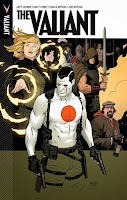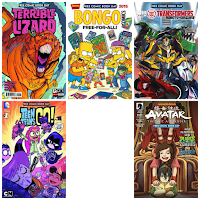If you get a chance, pop on over to Spook and read my piece on subversive josei manga and...WHAT? Armageddon is here?! No time for chit-chat! Fuel up your Doof Wagons! FOLLOW THE WOMEN!
COMICS OF THE WEEK :
GRENDEL OMNIBUS 4: PRIME
By Matt Wagner, Patrick McEown, Greg Rucka & Bernie Mirault
Published by Dark Horse Books
GRENDEL TALES: HOMECOMING
By Pat McEown & Dave Cooper
Published by Dark Horse Books
BLACK RIVER
By Josh Simmons
Published by Fantagraphics
APOCALYPTIGIRL: AN ARIA FOR THE END TIMES
By Andrew MacLean
Published by Dark Horse Books
“She’ll have to die, of course...I will not have my authority undermined by a single, meddling ant.”—Buster the Large, Grendel Tales: Homecoming.
Apocalyptic thoughts of late.Apocalyptic pop culture of late. Bear with me here...the road’s long and winding and even I’m not entirely sure what’s at the end of it...
The admittedly scarce criticisms (those worthy of discussion, anyway) of Mad Max: Fury Road have mostly left me scratching my head. Either filed under “violence isn’t feminist” or “ugh, so much action, ” those critical of the film seem ignorant of just how much Fury Road reshapes the territory in which it operates chiefly because they don’t like actions films. This distaste for things frequently going ka-boom is fine in and of itself, but to criticise a great action film for being an action film is like criticising a comedy for having too many well-crafted gags. As for the “this film is not feminist” arguments, aside from mentioning that Fury Road ends with the establishment of a new matriarchy, I would refer you to Alexandra Heller-Nicholas, who does a far better job at skewering this than I ever could. The only critical quibble to which I can reasonably shrug my shoulders and go “fair enough” comes from those who feel that the lightning pace prevented necessary character development and, as a result, they could not connect with the cast. I don’t agree with that, but I can at least understand it. The fact is, somewhat improbably, Fury Road is a hit. Personally, I think it’s the best action film of all time.
While it’s the zombie that’s obviously been the recent apocalyptic motifdu jour, all of a sudden it’s as if the (mostly) faceless undead, long functioning either symbolically (see Dawn of the Dead) or as a looming threat to darken and propel onward interpersonal dramas (see The Walking Dead), are giving way to an apocalypse of far more realistic, personal and decidedly gendered nature. Although Fury Road was admittedly gestating for over a decade, it’s hard not to feel that right this very minute the party punch is being gleefully spiked, the zeitgeist is shifting. However you want to phrase it, we are all living in the fever dream of a very different kind of pop culture apocalypse, a world in which pro-active, goal-oriented females roam, firearms loaded, vehicles fuelled. Chauvinist ideologies explode like Krypton as bros with the old-school, “get behind me, woman!” mentality are unable to oil up their pecs and strap on their slippery tough-guy leather gear in time to stop these trigger-happy furies from aiming weapons right at their heads.
From recent comics past, I can immediately think of several examples of the apocalyptic/dystopic femme. For example, there’s Judge Anderson of Judge Dredd, Martha Washington of Give Me Liberty, Agent 355of Y: The Last Man and Fatima of Fatima: The Blood Spinners. However, for our purposes here, let’s consider arguably two of the most extreme, radically contrasting portrayals of post-apocalyptic comic book woman.
Firstly, there’s Druuna (1995-2003) by Paolo Eleuti Serpieri. Druuna was a very famous, very popular, pouty, curvaceous, rag-clad character from European comics who shagged her way (frequently unwillingly) through a seedy post-apocalypse filled with leprous-looking males and ruined urban environments. She was perhaps the unfortunate It Girl of the period when Heavy Metal became less about mind-bending Euro SF and mostly about titillation. There’s a lot more to Drunna’s tale than this reductive encapsulation allows (there’s actually a clever twist), but in the wake of Fury Road, the “adventures” of this pneumatic, constantly objectifiedcharacter feel more than ever like comic book gender fossils.
Secondly, there’s Susan Veraghen from the tail-end of Matt Wagner’s centuries-spanning “aggression study,”Grendel (Wagner, while we’re on the subject, does not get the credit he deserves for the diversity of his characters. The man is a pioneer). We can quibble over whether or not the futuristic world the character finds herself in is post-apocalyptic, but as it’s seriously dystopic, inparts heavily-irradiated from nuclear attack and filled with mutants and monsters, let’s just agree that it’s at least Mad Max 1 bad....
[NOTE: Both War Child & Past Prime are collected, along with even more material, in the fourth Grendel Omnibus collection. All four volumes are highly recommended, but not essential to the tale].
Even though War Child feels very much like the Mad Max of the overall legend, with its decompressed pages (by Grendel standards), Grendel-punk gangs, desert hover bike chases, leather-bondage gear of protagonist Grendel Prime and overall grittiness and emphasis on action, it’s Homecoming that I make particular note of here. Over the span of 60 beautifully illustrated pages, McEown and Cooper elevate Susan from stoic, dangerous, big-hearted defender to a lethal, avenging, misogynist-killing, proto-Furiosa. Cooper’s painted colour art (over McEown’s pencils) steals the show, grubbing up landscapes and giving everything incredible depth and richness. In fact, Homecoming has the look of a Euro SF comic, which for 1994, at the height of the original Image Comics Madness, was incredibly distinctive.
McEown’s story is the classic, some would stay stereotypical, revenge narrative, but with Susan in place of the revenger filled with righteous fury, who becomes oddly empowered through the death of a loved one. Although undoubtedly rushed and its climax somewhat disappointing, Homecoming is a short, sharp triumph of a comic, visually the crowning moment of a character who more than deserved a series of her own yet who is virtually forgotten, left to twiddle her thumbs in comic book limbo until someone discovers her stories in a remainder bin.
Obviously the most well known comics in the Black River vein are The Walking Dead and Crossed. Neither of these titles comes close to capturing the despair and, more importantly, the horrific reality of violence that Black River contains. The Walking Dead has always struck me as something of a post-apocalyptic soap opera with Kirkman frequently struggling to reign in his melodramatic leanings. Crossed only works for me when it is treated seriously and played completely straight (so basically when Garth Ennis writes it). It’s otherwise difficult to get past the sexualised violence and the constant attempts at gore-soaked titillation, which, ironically become desensitising, boring and lazy: oh look, another taboo-smashing sex act, oh gee, that man’s wearing a face on his genitals...
Simmons lingers uncomfortably on scenes of brutality and death as if to chide us for this potential fondness for nastiness and despite his scratchy cartooning, Black River is the most realistic book of its type produced in quite some time. The journey of these poor,filthy, fraying, unwashed, realistic, battle-weary women making their way across an endless ruined landscape, avoiding (male) killers and clinging on to their sanity is harrowing. Here, death is arbitrary. It comes, not just in the form of gangs but also in accidents, in bad luck, suicide. It comes suddenly and unexpectedly, its ability to shock and sadden is not limited to simply visceral, gory set-pieces or male on female violence.
In typical Simmons fashion the comic is also very strange. Blessed with an uncanny ability to disquiet readers, in Black River, he takes his levels of uncomfortableness to new heights. An early visit to a comedy club features such odd character interaction you’ll squirm in your seat. One character’s psychological breakdown and subsequent self-harm are treated by others as just one of those post-apocalyptic things. Time passes and neither reader nor character seems to know exactly how much. And it’s all presented with a documentarian’s eye for human interaction and a skilled cartoonist’s gift for expression.
Simmons’ book also comes with an eye-catching, almost disarming cover design by indie comics genius, Sammy Harkham, and its mint-edged pages complimenting a swirling cursive logo belie the black and white horrors lurking within its pages. At one point, a stoned, traumatised character with tears streaking her cheeks and a smile on her face says, “I can’t wait to see how much worse things can get.” I’m not sure if Simmons is commenting on himself creating the book, or his readers, but it feels like a potent piece of fourth wall smashing to me, a little stab at us and our proclivities for this kind of material, and maybe at himself for making it. Be prepared to feel a little strange and more than a little grubby when you read Black River, but that’s okay; that’s really how you’re supposed to feel.
Aria and Jelly Beans inhabit a world of such beauty, even she acknowledges, “You know, for an apocalypse, it ain’t all bad,” as she enjoys the sun setting over intricate, crumbling skyscrapers overgrown with leafy flora and geometrically-attractive water reserves stretching off to the horizon.
Beware though: while the griminess and nihilism of Black River is not present, there’s still much darkness amid the lush, Dave Cooper Homecoming-esque colours. Aria’s machete-fights with the tribal Blue Stripes and their hunting dogs are thrilling and bloody bouts. MacLean packs a lot in to his tale, a rich mythology, warring tribes, numerous, brilliantly staged action-sequences, and a lot of heart. Aria, as adept and fixing machinery as she is swinging her blade, is wonderfully realised in an effusive style reminiscent of everyone from Jeff Smith, to Michael Avon Oeming, and touches of dozens of other cartoonists -- you’ll likely spot a glimmer of a different artistic influence almost every page. Gorgeously colourful, there is much joy to be found in Aria’s thrilling escapes from the brutes that stalk her and in her endless capability in all circumstances, recalling that of a fellow cat-lover, Ellen Ripley, albeit a Ripley infused with a tonne of extra youthful enthusiasm and energy.
MacLean’s world building is exquisite, with ruined cityscapes; subway tunnel bunkers; lush orchards; mammoth, earth-toned robots; the monstrous, Genndy Tartakovsky-ish Greybeards; the modern tribalism of the Blue Stripes; assorted tech and, of course, Aria and Jelly Beans, all attractively, strikingly designed and constructed. It’s beautiful work.
ApocalyptiGirl is also a lovely little comics object, handsomely designed and packaged. MacLean’s book shall also forever be Exhibit A in why matte paper is far superior to glossy in showing off the beauty of line art and the rich, painterly possibilities of the colour palate.
As of right now, considering all of this, it’s hard to imagine something like Druuna, as loving crafted as it was, ever happening again on a level approaching even the vaguely mainstream. The abused, submissive, tattered-clothed fleshpot of Serpieri’s work has finally been put out of her misery. Run over in this post-Furiosa comics-world of Susan Veraghens, Druuna’s remains are recast as a relic from a pornified past-apocalypse.
Hopefully, that’s where she stays.
Hail Susans.
WEBCOMIC OF THE WEEK : ROMANTICALLY APOCALYPTIC
By Vitaly S. Alexius & co
Proving that the apocalypse can still be about dudes too is Romantically Apocalyptic, an oddly slice-of-life webcomic about a few guys named Captain, Pilot, Sniper and Engie buddying up and entertaining each other through nuclear winter. Most of the amusement stems from the incongruousness of this masked, militaristically-costumed crew acting like a pack of teenage goofs. Hilariously grim, the comic switches from conversational snippets to panoramic landscape shots of a ruined world that Alexius puts together using "Photoshop, live actors, dead actors, sexy assistants, greenscreen, a camera, and a Wacom tablet."
The End Times have never been so much fun.
COMICS VIDEO OF THE WEEK : FIST OF THE NORTHSTAR
Even *more* dudes of the apocalypse! Take that, ladies! Manly, leather-bound, vascular,powerhouse men of the sort that those MRA boycotters would surely give the big A-OKAY to, punch each other silly in this adaptation of the classic manga by Buronsen and Tetsuo Hara. This 1986 film is in many ways the Fury Road those guys actually wanted, proving just how wildly out of touch they really are. Ironically, North Star opens as a virtual parody of Fury Road when pugilistic wanderer Ken battles pugilistic wanderer Shin over the explicitly literal possession of a woman named Julia – who wears a thin white dress – in a desert landscape on a post-apocalyptic earth. I swear I’m not making this up. To say things then escalate in numerous furiously fistic ways is an understatement.
Mad Max’s aesthetic permeates North Star, from hero Ken’s outfit, to the various gangs throughout the film/manga, there’s even some extended vehicle chases slipped in amongst the martial mayhem. There’s also an oddly subdued, aloof English voiceover in this version, very strange for anime. It’s almost as if in an effort to be apocalyptically downbeat, the cast broke open the world’s last known bag of Quaaludes. Anyway, check it out, it’s visceral, fighty, hilariously un-PC stuff for you to flex your guns to, brothers and sisters!
See you next week. Love your comics.
Cameron Ashley spends a lot of time writing comics and other things you’ll likely never read. He’s the chief editor and co-publisher of Crime Factory (www.thecrimefactory.com). You can reach him @cjamesashley on Twitter.










.jpg)




















